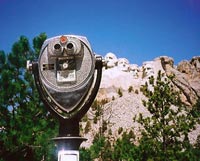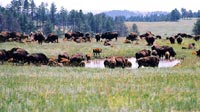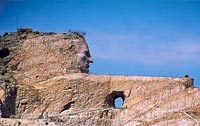Getting
Out There: |
Directory of all "Getting Out There" Articles> |
South Dakota by Peter Thody
|
DAY 4: RAPID CITY TO CUSTER STATE PARK & THE CRAZY HORSE MEMORIAL
Our first port of call the next day was another great American institution. Like the Empire State Building, '50s motels, and Old Faithful, Mount Rushmore is Americana personified, a place so familiar you feel you've been there before. Presidents Washington, Jefferson, Roosevelt, and Lincoln carved into a southeast facing wall of granite in the Black Hills; each sixty feet high and created over the impressively short period of fourteen years (only six-and-a-half of which were actually spent carving) by sculptor Gutzon Borglum.
Such is the feeling that this is part of an older America that the scale and modernity of the car parks, book shops, visitor center, restaurant, Avenue of Flags, and Grandview Terrace feel unnecessarily commercial even by US standards, but that doesn't detract from the "wow" factor of this national treasure. And by following the half-mile Presidential Trail - a scenic boardwalk that takes you away from the crowds but closer to the rock face, you can imagine that it's 1959 and -- look, isn't that Cary Grant on George Washington's nose? Well, no, actually, it's not. It's one of team of German contractors flown in to give the monument its first thorough cleaning in over sixty years.
Heading south now towards Custer State Park, we follow what we later discover to be the Iron Mountain Road, also known, more prosaically, as Highway 16A. Just 17 miles long, this is a totally unexpected delight, providing long distance views of Mount Rushmore through three strategically positioned tunnels, plus the experience of rising up through the forest on 'pigtail' bridges, a term which perfectly describes these spiraling wooden structures.
Custer State Park began life as a game reserve in 1913 with the aim of rebuilding the wildlife population that had been all but wiped out after an expedition led by George A. Custer discovered gold in the Black Hills in 1874. Today there's a herd of some 1,500 bison, plus mountain goats, elk, bighorn sheep, coyote, and a herd of wild burros, first introduced to haul visitors around the park but now roaming free.
To be honest, our trip around the Wildlife Loop Road, taking in a quick lunch at a lodge, meant we saw only a fraction of the place. We bumped into burros, negotiated bison dozing beside the road, and passed a number of busy-looking camp grounds, but this really wasn't a place to be appreciated by people on a road trip with miles to cover. It's somewhere to relax, fish, explore, hike, swim, ride and - we discovered from the official leaflet we were handed on entering the park - build snowmen.
An hour or so later, we pulled up in front of our second sculpture project of the day, the Crazy Horse Memorial. While this somehow lacked the immediate impact and sense of déjà vu of Mount Rushmore, its story is one of almost unimaginable determination on the part of one man.
Persuaded by the words of Lakota Chief Standing Bear, "My fellow chiefs and I would like the white man to know the red man has great heroes, too," sculptor Korszak Ziolkowski set about carving Crazy Horse in 1948. With just $174 to his name, no federal funding (twice declining offers of $10 million) and equipment that consisted of a jackhammer and gas compressor, this was such a mammoth undertaking that even today no one is prepared to say when it will be finished.
When Korszak died in 1982, he left behind not only the foundations of a piece of work which, when completed, will be 641 feet long by 563 feet high, but also a wife and ten children, most of whom have now taken up their father's jackhammer and are continuing his work. For an idea of just how much remains to be done, Crazy Horse's face was only completed in 1998, the project's 50th anniversary. Since then the family's efforts have been focused on blocking out the 22-story-high horse's head.
The Crazy Horse Memorial will some day become a modern wonder. Until then, it's a work in progress that honors the Native American and provides a lasting tribute to the commitment, patience, and skill of one man. It's also a project that makes you think: is there anything I believe in so strongly that not only would I have to dedicate the rest of my life to creating it, but also the lives of my children, their children, and quite possibly half a dozen generations more?
No, probably not. So we head for historic Deadwood and its promise of beer and slot machines.
Peter Thody
January 8, 2006



